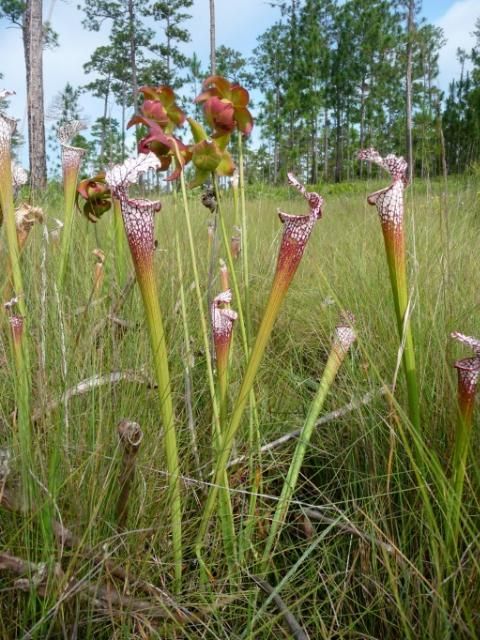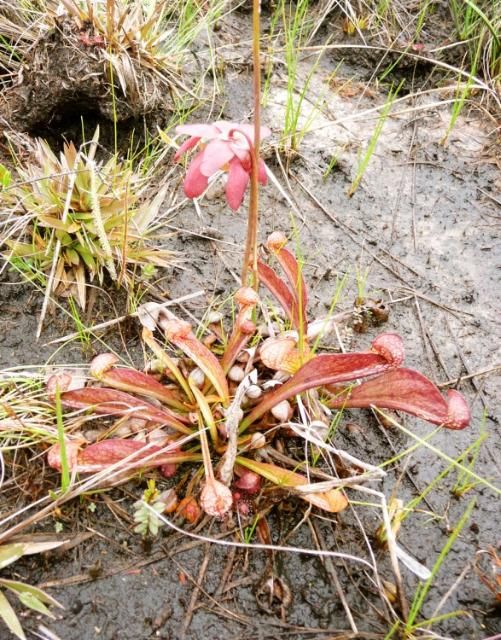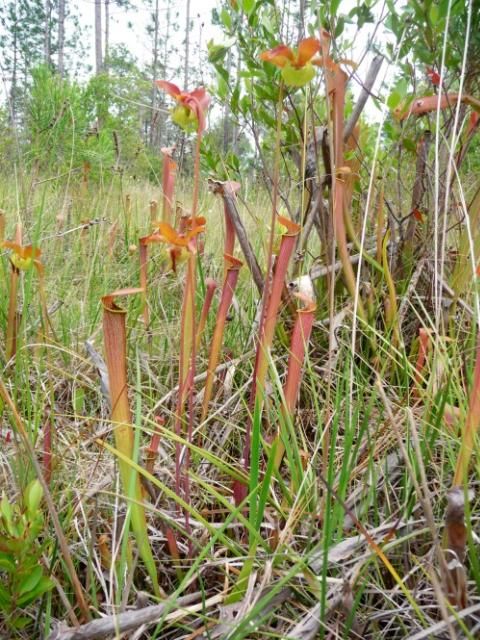Pitcherplants are members of the family Sarraceniaceae, which is named after Dr. Michel Sarrazin, a physician and naturalist from Quebec. In the beginning of the 18th century, Dr. Sarrazin sent live Sarracenia purpurea specimens to the French botanist Joseph Pitton de Tournefort for classification. This made Sarracenia the first genus of pitcherplants discovered in the New World.
Pitcherplants are perennial plants with groups of leaves modified into traps or pitchers. Early botanists described Sarracenia species incorrectly. M. Catesby (1754, 70) stated that the pitchers "always retain some water, and seem to serve as an asylum or secure retreat for numerous insects from frogs and other animals, which feed on them." In 1815, James MacBride developed the idea of carnivory after he discovered in his experiments that Sarracenia pitchers trap insects.
Pitcherplants have tubular leaves with lids or hoods at the top that secrete nectar to attract prey. Once insects are on the lip of the pitcher, they can slip on the waxy opening and fall into the plant. Hairs on the inside of the trap point downward, preventing insects from crawling back up. Plants also secrete digestive enzymes and fluids in the pitcher so that insects are digested and absorbed after they drown or die of exhaustion. Digested insects provide pitcherplants with nitrogen, which is usually limited in the acidic conditions where the plants grow. Most often, ants, flies, wasps, and bees are caught in pitcher traps.
More species of carnivorous plants flourish in the wetlands of Florida than anywhere else in the country (Hermann 1995). Six species of Sarracenia are found in Florida. These species inhabit open-canopy savannas that are wet or moist year-round. Pitcherplants are also found in wet prairies, wet flatwoods, seepage slopes, streamside seeps, and the edges of dome swamps and depression marshes.
Research estimates that less than 3% of the original Sarracenia habitat along the Gulf Coastal Plain remains (Folkerts 1982). In the past, these wet environments were commonly drained for pine plantations or urban development or converted into ponds. Decades of infrequent or low-intensity fire have resulted in woody species encroaching on much of the remaining habitat. Fire keeps woody species at a reduced height. In the absence of fire, these species grow to shade out and kill the sun-loving herbaceous vegetation, including pitcherplants.
Ditches, canals, plowed fire lines, roads, dams, berms, borrow pits, and artificial impoundments have altered the hydrology of the habitat to the detriment of pitcherplants. Rooting by feral hogs (Sus scrofa) also disturbs the soil, posing one of the most significant threats to pitcherplant habitat. These stresses on the biological system are further complicated by a lack of baseline species inventories of pitcherplant habitat on state-owned land (parks), inaccurate mapping, and insufficient monitoring. Consequently, Florida lists five of the six native pitcherplant species as threatened or endangered (Johnson 2001).
A few management strategies could increase protection of pitcherplants and their habitats. First, completing baseline surveys and continued monitoring can help detect changes in pitcherplant populations. Frequent prescribed burning with relatively high-intensity fires can help to control hardwood species. Sites with disrupted hydrology should be restored when possible. Feral hog disturbance is a threat that can be monitored, so fencing areas and removing hogs can help reduce or eliminate impacts (Johnson 2001).
The public can also play a role by not collecting pitcherplants from the wild and only purchasing plants grown by respectable retailers. With so many other human-induced pressures, poaching wild populations is unethical and a threat prohibited by law (McPherson 2007). Signs explaining pitcherplants and their threatened status may help deter poaching in parks where visitors can find them (Johnson 2001). Following these recommendations will help to conserve these remarkable plants and their habitats.
Below are descriptions of the ranges, appearance (morphology), and flowering (phenology) of the six pitcherplant species native to Florida.
Yellow Pitcherplant
Scientific name: Sarracenia flava
Other names: Yellow trumpet
Status in Florida: Obligate wetland (i.e., occurs in wetlands > 99% of the time)
Range: S. flava can be found in the Atlantic and Gulf Coastal Plains of southeastern Virginia, North Carolina, South Carolina, Georgia, western Florida, and Alabama.
Distribution in Florida: Alachua, Bay, Calhoun, Columbia, Escambia, Franklin, Gadsden, Gulf, Hamilton, Holmes, Jackson, Leon, Liberty, Okaloosa, Santa Rosa, Wakulla, Walton, Washington
Habitat: Mixed-grass wet prairies, wet flatwoods, seepage slopes, streamside seeps, and wet prairie ecotones of dome swamps and depression marshes
Description: The erect and tubular pitchers of S. flava can grow from 40 to 70 cm tall. Yellowish green in color, the pitchers have a reddish-purple blotch at the back of the opening. The large flower is bright yellow in color.
Time of flowering: March to April
Fun fact: The color of S. flava pitchers is the most variable of any species of Sarracenia. Colors range from yellowish green to crimson and even yellow with red venation.

Credit: M. Brown
Whitetop Pitcherplant
Scientific name: Sarracenia leucophylla
Other names: Swamp lily
Status in Florida: Endangered-state, obligate wetland
Range: S. leucophylla is only found along the Gulf Coastal Plain, from the Florida Panhandle west to southeastern Mississippi, extending north into extreme southwestern Georgia.
Distribution in Florida: Bay, Calhoun, Escambia, Franklin, Gulf, Holmes, Liberty, Okaloosa, Santa Rosa, Walton
Habitat: Mixed-grass wet prairies, wet flatwoods, seepage slopes, streamside seeps, and wet prairie ecotones of dome swamps and depression marshes
Description: S. leucophylla produces several noncarnivorous leaves during the early summer that taper to a slender point. The erect and tubular pitchers are green at the base and fade into white with red and green venation at the opening. The pitchers are usually about 40–70 cm tall. The color of the flowers can be bright crimson or maroon.
Time of flowering: March to May
Fun fact: The name leucophylla actually describes the coloration of the pitchers. Leucophylla comes from the Greek words leukos and phyllon, meaning white leaf.

Credit: M. Brown
Hooded Pitcherplant
Scientific name: Sarracenia minor
Status in Florida: Threatened-state, facultative wetland (i.e., occurs in wetlands 67%–99% of the time)
Range: S. minor can be found in the Atlantic and Gulf Coastal Plains from southern North Carolina into northern Florida.
Distribution in Florida: Alachua, Baker, Brevard, Clay, Columbia, Dixie, Duval, Flagler, Franklin, Gadsden, Gilchrist, Gulf, Hamilton, Hardee, Highlands, Hillsborough, Indian River, Jefferson, Lafayette, Lake, Leon, Levy, Liberty, Madison, Marion, Nassau, Okeechobee, Orange, Osceola, Pasco, Polk, Putnam, St. Johns, Sumter, Taylor, Union, Volusia, Wakulla
Habitat: Mesic and wet flatwoods, seepage slopes, cutthroat grass wet prairies, margins of depression marshes and dome swamps, and seepage ecotone between dry prairies and wet prairies
Description: The erect and tubular pitchers are usually 15–25 cm tall and 1.5–3 cm wide at the opening. The leaves fade from a yellowish green at the base to a pinkish red at the hood-like lid. S. minor is the only species of Sarracenia to have a lid that curls over the pitcher opening. The yellowish-green flowers are about as tall as the pitchers.
Time of flowering: April to May
Fun fact: All leaves produced by S. minor are carnivorous pitchers.

Credit: L. Reeves
Parrot Pitcherplant
Scientific name: Sarracenia psittacina
Status in Florida: Threatened-state, obligate wetland
Range: S. psittacina can be found from southeastern Louisiana east to the Florida Panhandle and north into southern Georgia.
Distribution in Florida: Baker, Bay, Calhoun, Escambia, Franklin, Gadsden, Gulf, Holmes, Jackson, Leon, Liberty, Nassau, Okaloosa, Santa Rosa, Wakulla, Walton, and Washington
Habitat: Margins of depression marshes and dome swamps, low areas in mesic flatwoods, wet flatwoods, mixed-grass and open-water wet prairies, seepage stream bogs, streamside seep, and edge of basin swamps
Description: The rosette of tubular leaves rests on the surface of the ground. The leaves are reddish green with white speckles and end in a hollow spherical structure. A tiny hole on the spherical structure is the only entrance to the trap. Prey insects enter the trap in search of nectar. Once inside, the prey follows the light shining through the white speckles on the trap in a futile attempt to find an exit. The prey must continue further into the trap because of the downward-directed hairs and eventually ends up in digestive enzymes. The traps are only 10–25 cm long and 1–4 cm wide. The flower is dark red to purple in color and is often the only visible portion of the plant because the leaves are hidden on the ground below surrounding vegetation.
Time of flowering: April to May
Fun fact: S. psittacina can even grow semiaquatically when its habitat is flooded periodically.

Credit: M. Brown
Gulf Purple Pitcherplant
Scientific name: Sarracenia purpurea syn S. rosea
Other names: Decumbent pitcherplant, northern pitcherplant
Status in Florida: Threatened-state, obligate wetland
Range: S. purpurea can be found from northeastern British Columbia to southern Newfoundland in Canada. It also inhabits the Great Lake states, New England states, Iowa, West Virginia, Maryland, New Jersey, Delaware, and the Atlantic Coastal Plain of Virginia, North Carolina, South Carolina, and Georgia. There is also a population in the mountains of North Carolina, Tennessee, and South Carolina. The range of S. purpurea continues along the Gulf Coastal Plain from southwestern Georgia, south to the Florida Panhandle, and west to southeastern Louisiana.
Distribution in Florida: Bay, Calhoun, Escambia, Gadsden, Holmes, Liberty, Okaloosa, Santa Rosa, Walton, Washington
Habitat: Streamside seeps, seepage slopes, seepage stream bogs, wet prairies, and wet flatwoods
Description: These pitcherplants grow to 10–15 cm in length and 2–4 cm in diameter at the opening. They are funnel shaped and narrow just below the opening, making the pitcher appear swollen. The lid has a wavy margin and offers little protection from rain because it is upright. The inside of the lid is covered with conspicuous 2–5 mm-long hairs that point downward. Color variants range from reddish purple to green with red veins. The flowers are reddish purple in color.
Time of flowering: April
Fun fact: S. purpurea inhabits the largest range of any American pitcherplant.

Credit: M. Brown
Gulf Coast Redflower Pitcherplant
Scientific name: Sarracenia rubra (ssp. gulfensis in the Florida Panhandle)
Other names: Sweet pitcherplant, red pitcherplant
Status in Florida: Threatened-state, obligate wetland
Threats in Florida: Populations are becoming increasingly isolated.
Range: There are disjunct populations in North Carolina, South Carolina, Georgia, the Florida Panhandle, and Alabama.
Distribution in Florida: Escambia, Okaloosa, Santa Rosa, Walton
Habitat: Mixed-grass wet prairies, seepage slopes, seepage stream bogs, and Atlantic white cedar baygalls
Description: The erect and tubular pitchers grow to a height of 12–60 cm and are 2–4 cm wide at the opening. They can be green or orange-red in color with red venation. The lid is oval or rounded, and the underside is often red. The color of the flowers is crimson or maroon.
Time of flowering: April to May
Fun fact: The subspecies, S. rubra ssp. gulfensis, is endemic to Florida's Gulf Coast (meaning that the species occurs nowhere else).

Credit: M. Brown
References
Catesby, M. 1754. The Natural History of Carolina, Florida, and the Bahamas: Volume II. London: Benjamin White Press.
Folkerts, G.W. 1982. "The Gulf Coast Pitcher Plant Bogs." American Scientist 70(3): 260–267.
Hermann, S. M. 1995. Status and Management of Florida's Carnivorous Plant Communities. Nongame Wildlife Program project no. GFC-84-033. Tallahassee: Florida Fish and Wildlife Conservation Commission.
Johnson, E. D. 2001. Pitcherplants and Their Habitats in the Florida State Park System: Resource Conditions, Trends, and Management Needs. Resource Management Evaluation. Tallahassee: Florida Department of Environmental Protection, Division of Recreation and Parks.
McPherson, S. 2007. Pitcher Plants of the Americas. Blacksburg, VA: The McDonald and Woodward Publishing Company.
Additional Information
The Botanical Society of America, Carnivorous Plants/Insectivorous Plants—https://botany.org/home/resources/carnivorous-plants-insectivorous-plants.html
The Center for Plant Conservation—http://www.centerforplantconservation.org/